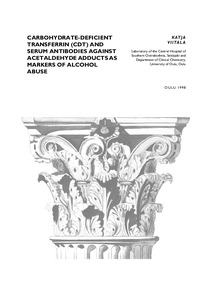Carbohydrate-deficient transferrin (CDT) and serum antibodies against acetaldehyde adducts as markers of alcohol abuse
Viitala, Katja (1998-10-30)
Avaa tiedosto
https://urn.fi/URN:ISBN:9514251075
Kuvaus
Tiivistelmä
Abstract
In the search for more reliable blood markers for excessive alcohol consumption, considerable effort has been devoted to measurements of carbohydrate-deficient transferrin (CDT), which increases in body fluids as a result of prolonged alcohol intake. In the present work, three CDT methods, CDTect (Pharmacia & Upjohn), %CDT radioimmunoassay (%CDT RIA) by Axis (Oslo, Norway), and Axis %CDT turbidimetric immunoassay (%CDT TIA) were examined for their diagnostic performance in cases of alcohol abuse with or without liver disease.
The diagnostic performance of CDT as a marker of alcohol abuse correlates positively with alcohol consumption. As compared with g-glutamyltransferase (GGT) and mean corpuscular volume of erythrocytes (MCV), which are conventionally used as laboratory markers of excessive ethanol consumption, CDT (CDTect) has the highest sensitivity (64%) at the specificity level of 100% in heavy drinkers consuming >100 g ethanol/day, but its sensitivity decreases to 34% in cases with an alcohol intake of <100 g/day, which hampers the use of CDT as a community screening method.
Patients with alcoholic liver disease (ALD) have significantly higher CDT values than alcoholics with non-liver pathology. However, CDT is primarily increased in cases with an early stage of ALD, so that there is a weak negative correlation between CDT and disease severity, which may prove to be of diagnostic value.
Especially in men, CDTect seems to achieve greater sensitivity than %CDT RIA or %CDT TIA for detecting recent alcohol abuse among heavy drinkers, but it does have a significant correlation with serum transferrin, especially in individuals reporting social drinking or no alcohol intake. This should be considered when interpreting the assay results in patients with increased serum transferrin. %CDT methods achieve greater specificity than CDTect when analyzing samples from patients with high serum transferrin concentrations.
Acetaldehyde-protein adducts are formed in the body after excessive ethanol intake, and their formation triggers antibody production, which may contribute to some forms of tissue damage seen in alcohol abusers. To obtain more information on the association between serum antibodies against acetaldehyde adducts, ALD and alcohol consumption, assays for antibodies against albumin and haemoglobin adducts were performed.
Antibodies of the immunoglobulin (Ig) isotypes A, G, and M against acetaldehyde-adducts are formed in patients with prolonged heavy alcohol consumption. IgA titres in ALD patients are significantly higher than those found in patients with non-alcoholic liver disease, non-drinking controls, or heavy drinkers with no signs of liver disease. Anti-adduct IgG titres, in turn, are increased both in ALD and in heavy drinkers with no signs of liver disease as compared with non-alcoholic liver disease patients or non-drinking controls. It appears that anti-adduct IgA, IgG and IgM titres in ALD patients correlate with the severity of the liver disease. Although this association is a limitation for the usefulness of these antibodies as markers of alcohol abuse, it may serve as a basis for the differential diagnosis of alcohol-induced liver disease.
Kokoelmat
- Avoin saatavuus [32523]
